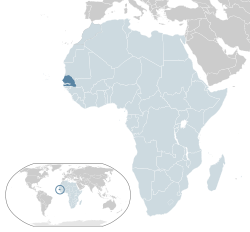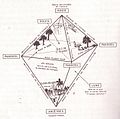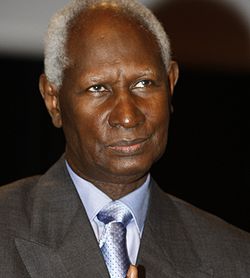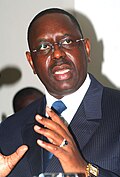Portal:Senegal
The Senegal PortalSenegal, officially the Republic of Senegal, is the westernmost country in West Africa, situated along the Atlantic Ocean coast. It borders Mauritania to the north, Mali to the east, Guinea to the southeast and Guinea-Bissau to the southwest. Senegal nearly surrounds The Gambia, a country occupying a narrow strip of land along the banks of the Gambia River, which separates Senegal's southern region of Casamance from the rest of the country. It also shares a maritime border with Cape Verde. The capital and largest city of Senegal is Dakar. Senegal is the westernmost country in the mainland of the Old World, or Afro-Eurasia. It owes its name to the Senegal River, which borders it to the east and north. The climate is typically Sahelian, though there is a rainy season. Senegal covers a land area of almost 197,000 square kilometres (76,000 sq mi) and has a population of around 18 million.0 The state is a presidential republic; since the country's foundation in 1960, it has been recognized as one of the most stable countries on the African continent. On the 2024 V-Dem Democracy Indices, Senegal is ranked 68th in electoral democracy worldwide and 10th in electoral democracy in Africa. The state was formed as part of the independence of French West Africa from French colonial rule. Because of this history, French is the official language, but it is understood by only a minority of the population. Over 30 languages are spoken in Senegal. Wolof is the most widely spoken one, with 80% of the population speaking it as a first or second language, acting as Senegal's lingua franca alongside French. Like other African nations, the country includes a wide mix of ethnic and linguistic communities, with the largest being the Wolof, Fula, and Serer people. Senegalese people are predominantly Muslim. As a developing nation, Senegal is classified as a heavily indebted poor country, with a relatively low ranking on the Human Development Index (169th out of 193). Most of the population lives on the coast and works in agriculture or other food industries; other major industries include mining, tourism, and services. The historic lack of natural resources in Senegal has redirected efforts towards increasing literacy and educational attainment. Senegal is a member state of the African Union, the United Nations, the Economic Community of West African States (ECOWAS), Organisation internationale de la Francophonie, the Organisation of Islamic Cooperation, and the Community of Sahel–Saharan States. (Full article...) Selected article -The House of Slaves (Maison des Esclaves) and its Door of No Return is a museum and memorial to the victims of the Atlantic slave trade on Gorée Island, 3 km off the coast of the city of Dakar, Senegal. Its museum, which was opened in 1962 and curated until Boubacar Joseph Ndiaye's death in 2009, is said to memorialise the final exit point of the slaves from Africa. While historians differ on how many African slaves were actually held in this building, as well as the relative importance of Gorée Island as a point on the Atlantic slave trade, visitors from Africa, Europe, and the Americas continue to make it an important place to remember the human toll of African slavery. (Full article...) Selected imagesSelected quotation -
Entries here consist of Good and Featured articles, which meet a core set of high editorial standards.
The Battle of Logandème (18 May 1859) was an uprising led by the Serer King Maad a Sinig Kumba Ndoffene Famak Joof, king of Sine, against the French Empire. The battle took place at Logandème (in Fatick) which was a part of Sine at the time. The battle was also a revenge attack against the Serer people after their resounding victory against France at the Battle of Djilass (or Tilas) on 13 May 1859. It was the first time that France decided to employ cannonball in the Senegambia. (Full article...) Selected biography -Abdou Diouf (US: /ˈɑːbduː diˈuːf/ ⓘ AHB-doo dee-OOF; Serer: Abdu Juuf; born 7 September 1935) is a Senegalese politician who was the second president of Senegal from 1981 to 2000. Diouf is notable both for coming to power by peaceful succession and leaving willingly after losing the 2000 presidential election to long-time opposition-leader Abdoulaye Wade. He was also the second Secretary-General of the Organisation internationale de la Francophonie from January 2003 to December 2014. (Full article...) General imagesThe following are images from various Senegal-related articles on Wikipedia.
Did you know -
WikiProjects
Related portalsAssociated WikimediaThe following Wikimedia Foundation sister projects provide more on this subject:
Things you can do
Discover Wikipedia using portals | ||||||||






































































